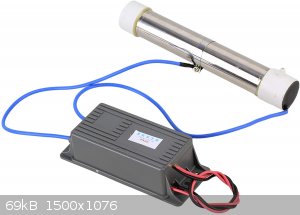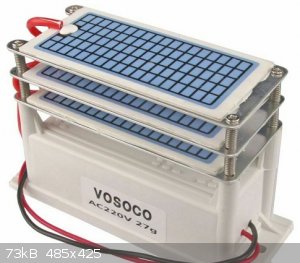SWIM
National Hazard
   
Posts: 970
Registered: 3-9-2017
Member Is Offline
|
|
liquid cooling for an ozone generator?
So, I've got one of these cheap ozone generators:
I know the electronics need replacing with something more durable, but I also want to get this thing to run as cool as is reasonably possible to
increase efficiency.
So I was wondering about immersing the whole tube in some non-conducting liquid that won't break down at the 5000 volts or so of potential these
things run off of.
Seems to me that I could get much lower operating temperatures this way than I could with air cooling by cooling the liquid with ice (via heat
exchanger) or a small refrigeration unit.
So it looks like regular mineral oil ought to do the trick, at least as far as I can tell.
However this sort of thing is way out of my line, so I wanted to ask If I'm missing something here that might not occur to a primitive screwhead like
me but would be obvious to somebody who understands alloys and compositions and stuff with molecular structures.
So what do you think?
A viable cooling strategy, or a great why to start an oil fire?

|
|
|
markx
National Hazard
   
Posts: 645
Registered: 7-8-2003
Location: Northern kingdom
Member Is Offline
Mood: Very Jolly
|
|
The problem with dielectric barrier discharge ozone generators mostly seems to be related to the longevity (or rather the lack of) of the dielectric.
The electronics rarely is the problem. So you might want to count on having to replace the tube quite often if it shall be run continuously for long
periods of time (days e.g.).
By the means of practical experimentation I've found that flat glass microscope slides with Al foil superglued to them serve as a rather durable
dielectric for ozone generators. Curiously, tube shaped designs seem to fail very shortly.
Liquid cooling systems can be a great way of complicating the maintenance of such a setup, so you might want to think twice if it is really required
for your purposes. Having to deal with oil or glycol soaked parts while disassembling is not really fun. Also I fear that after a while the coolant
shall find it's way through into places that it should not reach. By the means of the "law of the constancy of evil".
Efficacy could also be increased by using oxygen instead of air as the feedstock for the system. I'd rather go that route if a high output O3 source
is a must.
[Edited on 7-7-2021 by markx]
Exact science is a figment of imagination.......
|
|
|
SWIM
National Hazard
   
Posts: 970
Registered: 3-9-2017
Member Is Offline
|
|
I was planning on using my oxygen generator actually (2 liters/min at 90% oxygen).
But I had nor Idea fused quartz tubes would be so perishable.
Maybe this is why you don't hear much about people making sulfuric acid or ammonium nitrate via ozone.
|
|
|
Mateo_swe
National Hazard
   
Posts: 505
Registered: 24-8-2019
Location: Within EU
Member Is Offline
|
|
Maybe you can coat the outside of the stainless steel tube with something that is isolating and conducts heat good.
Then keep the whole ozone generator tube in a ice-bucket.
Doesnt sound good to put a high voltage device into a bucket of water, i would be very careful.
If would guess, cooling (and drying) the oxygen feed would work best but i have no ideas how to do it in a good way.
A couple of loops of oxygen tubing in a ice bucket, a drying tube and then into the ozone generator maybe.
|
|
|
SWIM
National Hazard
   
Posts: 970
Registered: 3-9-2017
Member Is Offline
|
|
My oxygen source is an oxygen concentrator that supplies 2 liters/min at 90% purity and fairly dry.
However I don't think 2 liters/min of cooled oxygen will do all that much cooling.
If I were using regular air I'd be pumping considerably more gas through the tube (I forget the rating, but it was more than the 10 L/min you might
expect) and the cooling potential might be adequate.
Oxygen in a high pressure tank could be supplied to the ozone tube at very low temperatures (say be cooling it with ice before the pressure is allowed
to drop), but I'm not crazy about keeping pressurized oxygen tanks around the house.
As for your first suggestion, I am hoping to coat the outside of the tube with something that is insulating and conducts heat well: Mineral oil.
Mineral oil in a sealed metal container with the ozone tube inside.
I have no numbers, but I strongly feel that this could allow for a very low operating temperature by externally cooling the container, and will likely
give decent operating temperatures without additional cooling if the oil reservoir is large enough.
These ozone tubes aren't going to put out much more heat than a lava lamp, so if one is sealed in an oil filled container 2 or 3 times the volume of a
lava lamp, and with a metal instead of glass exterior the temperatures shouldn't get too high (although much higher than if you nestle the container
in ice.)
In addition, the container will heat up slowly enough that it will only reach thermal equilibrium after 1/2 hour to an hour of running, so for
shorter term applications the tube won't get very hot at all.
However I've got to admit the thought of just epoxying the outside so I can just dump it in water is attractive, but I'm not clear on how well an
epoxy coating would insulate against that kind of voltage.
A few cm of mineral oil sounds more likely to do the job to me, and as it is a liquid it can convect around when it starts heating.
I suppose I should try out the tubes with conventional air cooling first and see if the results are satisfactory before I start innovating in a quest
for slightly higher efficiency.
I can always cool the ozone immediately after it comes out of the tube to limit any breakdown.
I do tend to over think these things sometimes.
|
|
|
Mateo_swe
National Hazard
   
Posts: 505
Registered: 24-8-2019
Location: Within EU
Member Is Offline
|
|
I think the mineral oil is a great idea, and it isolates any high voltage good.
If you then can continuously cool the mineral oil maybe you can run it for even longer periods.
I also have a DIY ozone generator setup i will test.
Its one of these plate type ozone generators found on auction sites.
Mine is rated 48g/hour, but i doubt that number even if fed with pure oxygen.
I have put the plates in a glass jar with the driver on the outside and put silicone tubing through the lid for input and output of air/oxygen and
ozone.
I plan to have the jar in an icebucket cooling it a bit.
It will be fun to see if it works.
Id love to have one of these oxygen concentrators that you have, i have seen them but they are a bit expensive.
If air works decent i might get one of those.
I plan to run the air through a drying tube before entering the ozone generator jar.
Halflife of Ozone dissolved in ph7 water:
Water at 15°C - 30 minutes
Water at 25°C - 15 minutes
Water at 35°C - 8 minutes
I read its about the same in air.
So high temps are really bad.

Attachment: Definitive Guide Ozone.zip (6.9MB)
This file has been downloaded 280 times
|
|
|
Mateo_swe
National Hazard
   
Posts: 505
Registered: 24-8-2019
Location: Within EU
Member Is Offline
|
|
I found a patent where they use a electrolytic process for the production of ozone that seem very interesting.
It might be better than the discharge method, i add the patent PDF if anyone want to read about it.
They use platinum or lead dioxide anodes and for example nickel cathodes.
In the patent they use an electrolyte consisting of water and highly electronegative anions, hexafluoro-anions preferred.
The lead dioxide anodes can be made with carbon/graphite rods used as a base and a lead dioxide layer is put ontop of the carbon/graphite in a cell.
Very interesting, i will look into the method more in detail.
And here is a video of making lead dioxide anodes using graphite rods and electrolytically put lead dioxide ontop of the graphite.
https://www.youtube.com/watch?v=tXSpqy2TNWo
Attachment: US4316782 - Electrolytic process for the production of ozone.pdf (310kB)
This file has been downloaded 180 times
|
|
|
SWIM
National Hazard
   
Posts: 970
Registered: 3-9-2017
Member Is Offline
|
|
Quote: Originally posted by Mateo_swe  |
I also have a DIY ozone generator setup i will test.
Its one of these plate type ozone generators found on auction sites.
Mine is rated 48g/hour,
Id love to have one of these oxygen concentrators that you have, i have seen them but they are a bit expensive.
If air works decent i might get one of those.
I plan to run the air through a drying tube before entering the ozone generator jar.
|
I was lucky in that I bought my oxygen concentrator some time before the pandemic. Prices have gone way up since then.
My Ozone generator is only rated at 6 gr/hr, but it's just for proof of concept.
I expect I'll want something bigger for making some chemicals in quantity.
Electrolysis does sound like an interesting alternative though.
|
|
|
kulep
Harmless

Posts: 46
Registered: 19-5-2018
Location: Somewhere below the tropic of Capricorn
Member Is Offline
Mood: Spicy
|
|
Why not just cool the oxygen supply? you're overcomplicating it if you try to cool the generator directly. Just run the oxygen through a copper tube
in an ice bath, dry ice or even inside a freezer.
If you cool the generator directly you could get condensation even if your source is very dry, at 5kv that's not so good.
|
|
|